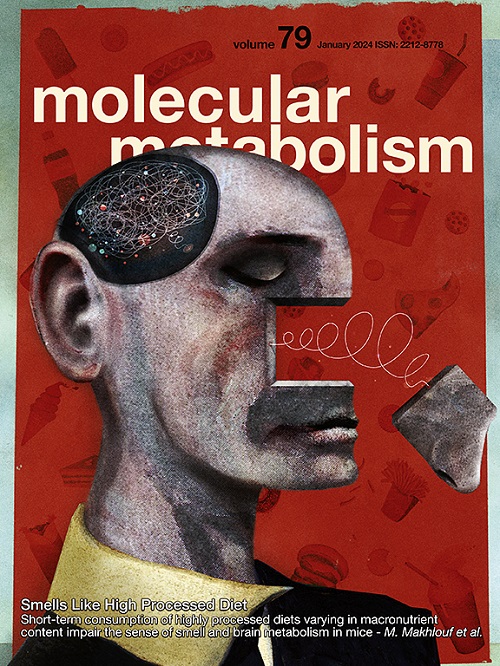IL-6解码性别和饮食依赖的昼夜节律和代谢节律。
IF 6.6
2区 医学
Q1 ENDOCRINOLOGY & METABOLISM
引用次数: 0
摘要
目的:白细胞介素-6 (IL-6)是一种参与免疫调节和能量代谢的多效细胞因子。其昼夜分泌影响核心昼夜节律成分,强调其在昼夜节律生物学中的关键作用。尽管已知免疫、昼夜节律和代谢过程存在性别差异,但IL-6如何整合这些过程仍知之甚少。方法:在标准(STD)和高脂饮食(HFD)、禁食和限时喂养条件下,对il - 6敲除小鼠(KO)和对照组小鼠进行昼夜节律和代谢性状表型分析。肌肉、肝脏和下丘脑的分子分析评估了时钟基因表达和IL-6信号通路。循环性类固醇激素被量化,以检查它们对观察到的性别特异性表型的贡献。结果:IL-6缺乏以性别和饮食依赖的方式破坏昼夜运动和代谢节律。男性在性病条件下表现出光照驱动的昼夜节律受损,在高热量饮食条件下表现出代谢失调,而女性在性病条件下表现出更强的昼夜节律恢复能力,但在高热量饮食条件下对昼夜节律中断的脆弱性增加。此外,IL-6作为食物可携带振荡器(FEO)的一种新的调节因子,以性别依赖的方式将STD和HFD下的食物预期活性和代谢周期联系起来。结论:这些发现表明IL-6是昼夜代谢可塑性的关键介质,在昼夜稳定和代谢稳态之间形成性别和饮食特异性权衡。我们的研究强调了IL-6作为缓解昼夜节律失调相关代谢紊乱的潜在治疗靶点,与IL-6信号的定时调节有关。本文章由计算机程序翻译,如有差异,请以英文原文为准。
IL-6 decodes sex and diet-dependent circadian and metabolic rhythms
Objective
Interleukin-6 (IL-6) is a pleiotropic cytokine involved in immune regulation and energy metabolism. Its diurnal secretion influences core circadian components, emphasizing its critical role in circadian biology. Despite known sex differences in immune, circadian, and metabolic processes, how IL-6 integrates these processes remains poorly understood.
Methods
IL6 knockout (KO) and control mice of both sexes were phenotyped for circadian and metabolic traits under standard (STD) and high-fat diet (HFD), fasting, and time-restricted feeding. Molecular analyses in muscle, liver, and hypothalamus assessed clock gene expression and IL-6 signaling pathway. Circulating sex steroid hormones were quantified to examine their contribution to the observed sex-specific phenotypes.
Results
IL-6 deficiency disrupts circadian locomotor and metabolic rhythms in a sex- and diet-dependent manner. Males exhibit impaired light-driven circadian rhythms under STD conditions and metabolic misalignment under HFD, whereas females display greater circadian resilience under STD conditions but increased vulnerability to circadian disruption during HFD. Additionally, IL-6 emerges as a novel regulator of the food-entrainable oscillator (FEO), linking food anticipatory activity and metabolic cycles under both STD and HFD in a sex-dependent manner.
Conclusions
These findings identify IL-6 as a critical mediator of circadian-metabolic plasticity, shaping sex- and diet-specific trade-offs between circadian stability and metabolic homeostasis. Our study highlights IL-6 as a potential therapeutic target for mitigating circadian misalignment-associated metabolic disorders, with implications for the timed modulation of IL-6 signaling.
求助全文
通过发布文献求助,成功后即可免费获取论文全文。
去求助
来源期刊

Molecular Metabolism
ENDOCRINOLOGY & METABOLISM-
CiteScore
14.50
自引率
2.50%
发文量
219
审稿时长
43 days
期刊介绍:
Molecular Metabolism is a leading journal dedicated to sharing groundbreaking discoveries in the field of energy homeostasis and the underlying factors of metabolic disorders. These disorders include obesity, diabetes, cardiovascular disease, and cancer. Our journal focuses on publishing research driven by hypotheses and conducted to the highest standards, aiming to provide a mechanistic understanding of energy homeostasis-related behavior, physiology, and dysfunction.
We promote interdisciplinary science, covering a broad range of approaches from molecules to humans throughout the lifespan. Our goal is to contribute to transformative research in metabolism, which has the potential to revolutionize the field. By enabling progress in the prognosis, prevention, and ultimately the cure of metabolic disorders and their long-term complications, our journal seeks to better the future of health and well-being.
 求助内容:
求助内容: 应助结果提醒方式:
应助结果提醒方式:


